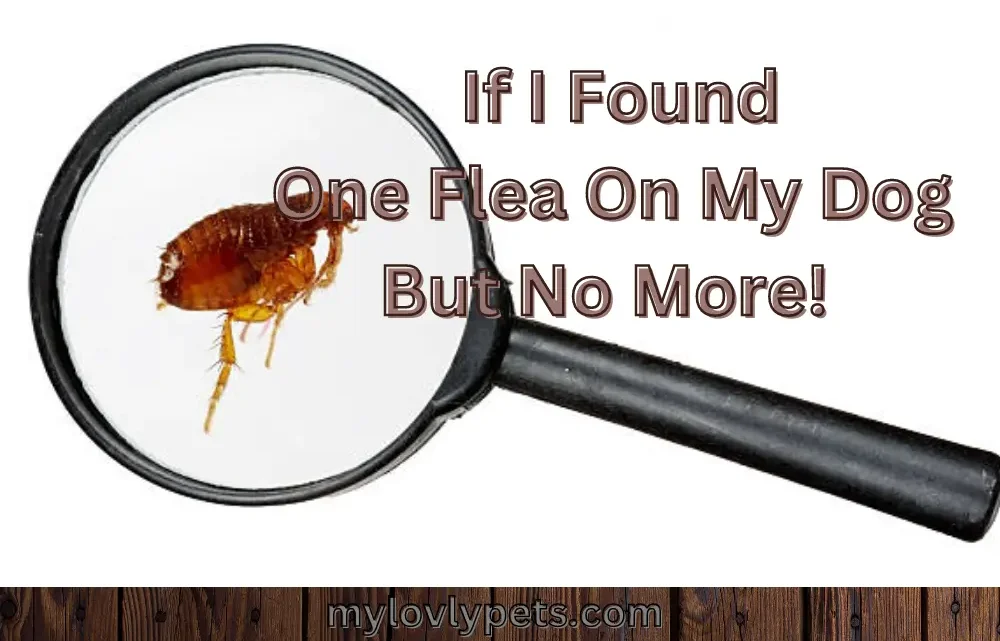
If I Found One Flea On My Dog But No More! What Is Solution
Even a single flea on your dog can cause scratching and irritation. However, how many fleas on a dog constitutes an infestation? Although there is no specific amount that indicates an infestation, even a few fleas may signal that many more are lurking in your dog’s fur and your home.
I found one flea on my dog but no more, you may believe it’s not a huge concern. If you’ve just walked your dog, a single flea is fine, but more than two could indicate a problem. It’s better to deal with fleas sooner rather than later.
How Fleas Affect Your Dog
Understanding how fleas work is one of the most important factors to consider when dealing with them. These tiny insects thrive in warm surroundings, and their lifecycle, which includes the stages of egg, larva, pupa, and adult, can last anywhere from two weeks to several months. They feed on their hosts’ blood, causing discomfort and perhaps spreading disease.

As a result, it is critical to take a diligent and regular approach to flea treatment. It aids in the full and total elimination of fleas and minimizes the likelihood of infestation recurrence.
I Found One Flea on My Dog But No More
Just one flea on a dog can be a sign of a problem, and that two adult fleas can lead to hundreds of eggs and pupae. Fleas start feeding on blood within minutes of landing on the pet, and a female can start laying eggs within two days.
Female fleas can lay 27 eggs or more each day in just four to nine days, and larvae can hatch from the eggs five to eleven days later, then grow into pupae within tiny cocoons. It is important to treat the fleas before they reach this stage, as the pupae are the hardest to kill. Even a few fleas on a dog can be a sign of a problem, so it’s important to act quickly to prevent an infestation.
Signs Your Pet Has Fleas

Fleas are a common cause of itching and scratching in dogs, as well as tiny black specks (called flea dirt) in their fur or bedding. Flea dirt can turn a dark red-brown color when sprinkled with water, and running a flea comb through the dog’s fur can also reveal fleas. Tiny white segments that look like grains of rice where the dog sleeps or sits are also signs of fleas.
Common Flea Treatments
Topical treatments, oral treatments, and collar treatments are all common ways to treat fleas in dogs.
Topical treatments are applied to the skin to kill the fleas and include over-the-counter products such as shampoos, sprays, powders, and spot-on treatments.
Oral treatments are usually administered through ingestion once a month and can kill adult fleas and inhibit the growth of eggs and larvae.
Collar treatments are another product that contains chemicals that repel and kill fleas and provide long-term protection, but needs to be used as per the manufacturer’s instructions.
By understanding these various treatments, you’ll be able to choose the best one for your dog’s flea condition.
Prevention Is Key
Prevention is key to preventing fleas from invading your home and yard. If you notice any fleas on your dog, it’s a sign that an infestation is underfoot. If you spot a few fleas, run a flea comb through your dog’s fur to see if there are more. By treating your dog, home, and yard right away, you should be able to avoid a major infestation in the future.
How to keep squirrels from invading your garage
Keep the environment clean
In addition to treatments, a clean and organized setting is very important for getting rid of fleas. Clean your dog’s bed, favorite spots to hang out, and play areas on a regular basis. When you vacuum, you can get rid of flea eggs and larvae from your carpets, rugs, and furniture. Try to clean and dust your dog’s area at least once a week to keep fleas from getting in.
Give your dog a balanced diet
The way a pet eats can also help keep fleas away. A dog with a strong immune system and good health is less likely to get a bad flea infection. Your pet’s natural defenses against fleas and other disease-causing pests can be made stronger by giving it a balanced diet full of essential nutrients.
To keep your dog healthy, feed high-quality canned or kibble food. Also, make sure your pet has access to clean water so it can stay hydrated. Lastly, talk to your vet about what your pet needs to eat.
Ask a vet
Before beginning any treatment program, always visit a veterinarian. They can provide vital advice based on your dog’s breed, size, age, health status, and the severity of the infestation due to their knowledge and expertise. They can also advise you on flea treatment alternatives and any adverse effects.
Follow the veterinarian’s directions attentively in their recommended treatment plan to ensure that the treatment is effective and safe for the pet buddy.
Factors to Consider When Treating Your Dog for Fleas
Keeping your dog flea-free does not have to be a difficult task. Aside from the ones listed above, there are a few more things to think about when it comes to safeguarding your pet against flea infestations.
These are some examples:
Keeping your dog’s coat clean, bright, and healthy while also giving you an opportunity to check for fleas. During grooming, use a fine-toothed flea comb to help remove adult fleas, eggs, and larvae from your dog’s fur.
Keep in mind that each dog is unique, and what works for one may not work for another. To maximize the success of your flea prevention and treatment efforts, tailor your approach to your dog’s individual needs.
In the case of a persistent or severe flea infestation, various techniques may be required. Combining environmental management methods, such as thorough cleaning and pest control services, with flea treatments such as shampoos, powders, or pills, could be an option.
Consider seasonal flea activity. Fleas flourish in warm, humid environments, making the spring and summer months ideal for infestations. As a result, it may be required to increase the frequency of flea checks and the severity of preventative measures during these times.
You can prevent your dog from fleas and help to their overall happiness and health by taking these strategies.
Conclusion
Flea treatment requires vigilance, prompt action, and preventive measures. You may properly manage and prevent these pesky pests if you keep this guide in mind. As a result, you can provide a safe and comfortable environment for your canine companion. After all, a happy dog equals a happy household.


